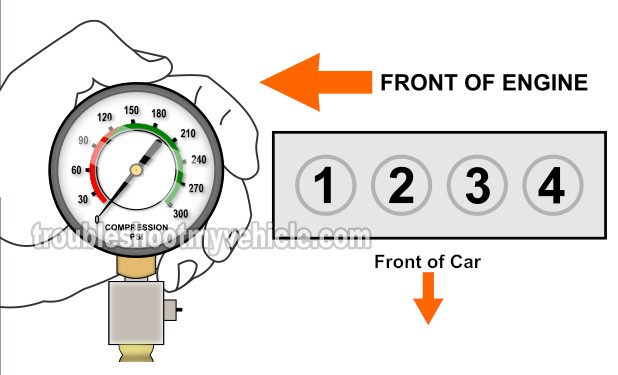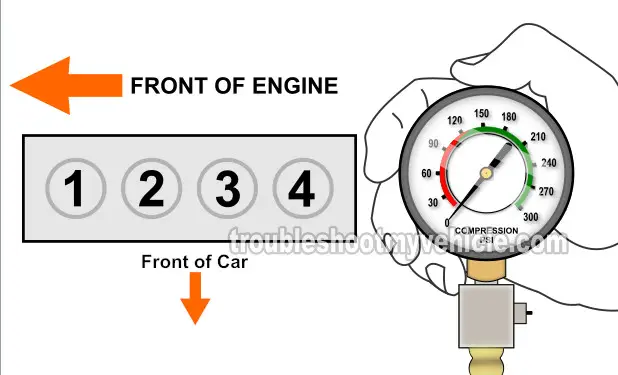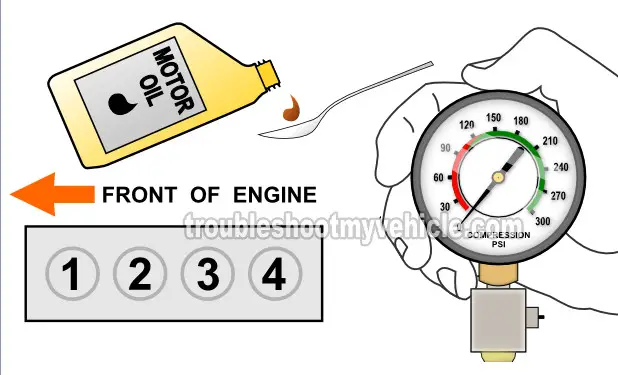
In this tutorial, I'm going to explain how to do a compression test and more importantly, I'm going to show you how to interpret your test results.
You'll be able to easily find out if a compression problem is causing a no-start problem or a misfire/rough idle problem on your 1.5L Mazda Protege.
Contents of this tutorial:
ES ![]() You can find this tutorial in Spanish here: Cómo Probar La Compresión Del Motor (1995-1998 1.5L Mazda Protege) (at: autotecnico-online.com).
You can find this tutorial in Spanish here: Cómo Probar La Compresión Del Motor (1995-1998 1.5L Mazda Protege) (at: autotecnico-online.com).
APPLIES TO: This compression test tutorial applies to the following vehicles:
- 1995, 1996, 1997, 1998 1.5L Mazda Protege.
Symptoms Of Low Or No Engine Compression
Over the years that I've been working on cars, as a professional automotive technician, I've noticed that engine compression problems usually fall into one of two types of categories.
In a nutshell, the engine compression problem will cause your 1.5L Mazda Protege to either:
- Crank but not start due to a lack of compression on all cylinders.
- The engine will start but run with a misfire/rough idle problem.
Here are some more specifics:
The Engine Starts But Runs With A Misfire:
- Also known as an engine miss, rough idle condition.
- Usually caused by very low compression in one cylinder.
- Is also caused by uneven engine compression that varies more than 15% across all 4 cylinders.
- Check engine light on with misfire codes (if your vehicle is OBD II equipped):
- P0300 Random Cylinder Misfire.
- P0301 Cylinder #1 Misfire.
- P0302 Cylinder #2 Misfire.
- P0303 Cylinder #3 Misfire.
- P0304 Cylinder #4 Misfire.
- Bad gas mileage.
- This is caused by the simple fact that the engine is NOT running with all 4 cylinders.
- Engine pollutes more.
- Low engine compression will cause the air/fuel mixture to not burn correctly. This means that unburned fuel escapes into the exhaust. If the cylinder has no compression, all that raw fuel is being sent into the exhaust.
The Engine Cranks But Will Not Start:
This usually is caused by having 2 or all 4 cylinders with no compression. When this happens, you'll see:
- The engine cranks very fast.
- This fast cranking speed is very noticeable.
- The ignition system is sparking all 4 spark plugs.
- This tells you that the no-start condition is not caused by a fault in the ignition system.
- The fuel injectors spray fuel.
- You can confirm this with a Noid light test.
- Also, you can confirm this, although indirectly, by removing the spark plugs and checking to see if they are fuel soaked (fuel fouled).
- Fuel pump is working and providing pressure.
- The most common causes of no compression on 2 or all 4 cylinders are:
- Blown head gasket.
- Broken timing belt.
- Engine threw a rod.
OK, let's get testing.
Which Compression Tester Should I Buy?
There are lot of engine compression testers to choose from and many places to buy them. I'm gonna' make some recommendations to you:
Disclosure: As an Amazon Associate, I earn from qualifying purchases. If my tutorials help you, using these links is an easy way to support the site at no extra cost to you. Thank you!
TEST 1: 'Dry' Engine Compression Test

To get the most accurate test result, from your engine compression test, it's important that you test the compression of all four cylinders.
Cool thing about the 1.5L Mazda Protege engine, is that accessing and removing the spark plugs is a piece of cake.
If you don't have a compression tester, you can run down to your local auto parts store and buy rent one from them. Or if you'd like to save a couple of bucks on its purchase, check out the links in the subheading above.
IMPORTANT: Never remove the spark plugs from a hot engine! If the engine has been running for any length of time, let it cool down completely before removing the spark plugs.
IMPORTANT: You'll be working around a cranking engine, so be careful and stay alert at all times. Think safety all of the time!
This is what you'll need to do:
- 1
Disable the fuel system by removing the fuel pump relay.
This will prevent fuel from being injected into the cylinders as you crank the engine. - 2
Disable the ignition system by disconnecting the distributor from its electrical connector(s).
Don't overlook this step, since disconnecting the distributor will prevent the ignition coil from firing spark during the test. - 3
Remove all four spark plug wires and remove all four spark plugs.
I recommend marking the spark plug wires before removing them so you'll know where they go when you put them back on.
As you're taking them out, be careful and don't drop any of them on the floor, or you could cause the spark plugs ceramic insulator to break, and this will cause a misfire! - 4
Thread the engine compression gauge into the spark plug hole for the number 1 engine cylinder (this is the spark plug hole closest to the drive belt).
IMPORTANT: Hand tighten the compression gauge only! Do not use any type of tool to get it tight. - 5
When the tester is set up, ask your helper to crank the engine. Your job is to keep your eye on the compression tester's gauge.
- 6
Once the needle on the gauge stops climbing, have your helper stop cranking the engine.
- 7
Write down the compression value on a piece of paper.
Include the number of the cylinder this reading belongs to. - 8
Repeat steps 3 thru' 7 on the remaining cylinders.
Let's take a look at what your test results mean:
CASE 1: Low or no compression in 2 or all 4 cylinders. This test result indicates a serious internal problem.
The most common issues would be:
- Blown head gasket.
- Broken timing chain.
- Engine threw a rod.
CASE 2: Low compression in one or more cylinders. To a certain point, it's normal for the compression to vary a little between cylinders (as the engine accumulates thousands of miles).
But if these values vary too much, then you're gonna' have a bonafide misfire on your hands.
The next step is to do some math to find out if this low compression value is within a normal parameter or not. Go to: Interpreting Your Compression Test Results.
Interpreting Your Compression Test Results
It's not unusual to see some variation in the compression readings, especially on high-mileage engines.
If the variation is small enough, you're not going to notice any type of engine performance problem.
But if the variation is too big, then you're going to see a misfire problem or a rough idle problem.
The cool thing is that we can easily find out if the low compression values are causing an engine performance problem or not.
To find out, we need to figure out if the low compression values are lower than 15% of the highest compression value you got.
You can do this (figuring out the 15%) in one of two ways: You can calculate this 15% difference with pen and paper or you can use my low compression calculator. You can find the low compression calculator here: Online Low Engine Compression Calculator (at: easyautodiagnostics.com).
If you want to manually calculate the 15% difference, here's what you'll need to do:
- STEP 1: Multiply the highest compression value by 0.15 (this is the decimal value of 15%).
- STEP 2: Round the result to the nearest one (for example: 25.6 would become 26).
- STEP 3: Subtract the result (the number that was rounded) from the highest compression value.
- ANSWER: The result of this subtraction is the lowest possible compression value any cylinder can have.
Now, let me give you a more specific example: Let's say that I got the following compression readings:
| Cylinder | Pressure |
|---|---|
| #1 | 165 PSI |
| #2 | 95 PSI |
| #3 | 155 PSI |
| #4 | 175 PSI |
My next step is to do the following calculation:
- STEP 1: 175 x 0.15 = 26.25.
- STEP 2: 26.25 = 26 (rounded to nearest one).
- STEP 3: 175 - 26 = 149.
- ANSWER: 149 PSI. Any cylinder with this compression (or lower) value will misfire.
Since cylinder #2 is only producing 95 PSI, I can now conclude that it's 'dead' and causing a misfire.
To find out if the lowest compression value you got from your engine compression test is within a good range, you'll need to do the same calculation. Of course, you'll need to use the highest compression value you got and not the one in the example.
Once you've found the 'dead' cylinder, the next step is to find out what's causing the low compression value. For this step, go to: TEST 2: 'Wet' Engine Compression Test.
TEST 2: 'Wet' Engine Compression Test

A low or 0 PSI compression value is usually the result of one of two things:
- The affected cylinder's piston rings are worn or damaged.
- The affected cylinder's intake or exhaust valves are severely worn or damaged.
To find out which is the case, we don't need to take the engine apart (just yet). We can do a 'wet' engine compression test to find out.
A wet compression test simply involves adding a small amount of engine oil to the cylinder with low or 0 PSI compression and then retesting its compression.
If the compression value shoots up, then we can conclude that the low or 0 PSI compression problem is due to the cylinder having worn/damaged piston rings.
If the compression value does not increase, then we can conclude that the low compression problem is due to the cylinder having worn/damaged intake or exhaust valves.
OK, this is what you need to do:
- 1
Add a small amount of engine oil to the cylinder that reported low compression or no compression in the 'Dry' compression test.
You don't have to add a lot of oil. The amount should be about 1 to 2 tablespoons of oil. - 2
Install the compression tester onto the cylinder.
Do not use any type of tool to tightened the compression tester. Hand tight is fine. - 3
When all is set up, have your helper crank the engine.
- 4
You'll get one of two results:
1.) The compression value will go up (from the one you recorded before).
2.) The compression value will stay the same.
Let's take a look at what your test results mean:
CASE 1: The compression value shot up. This tells you that the piston compression rings are worn out and thus the problem is in the bottom end (block) of the engine in your 1.5L Mazda Protege.
CASE 2: The compression value stayed the same. This confirms that the low compression problem of the affected cylinder is due to worn or damaged cylinder head valves.
More 1.5L Mazda Protege Tutorials
You can find a complete list of 1.5L Mazda Protege tutorials in this index:
Here's a small sample of the tutorials you'll find in the index:
- How To Test The MAF Sensor (1996-1998 1.5L Mazda Protege).
- P0122 -What Does It Mean? (1996-1998 1.5L Mazda Protege).
- P0123 -What Does It Mean? (1996-1998 1.5L Mazda Protege).
- How To Test The TPS (1996-1998 1.5L Mazda Protege).

If this info saved the day, buy me a beer!





